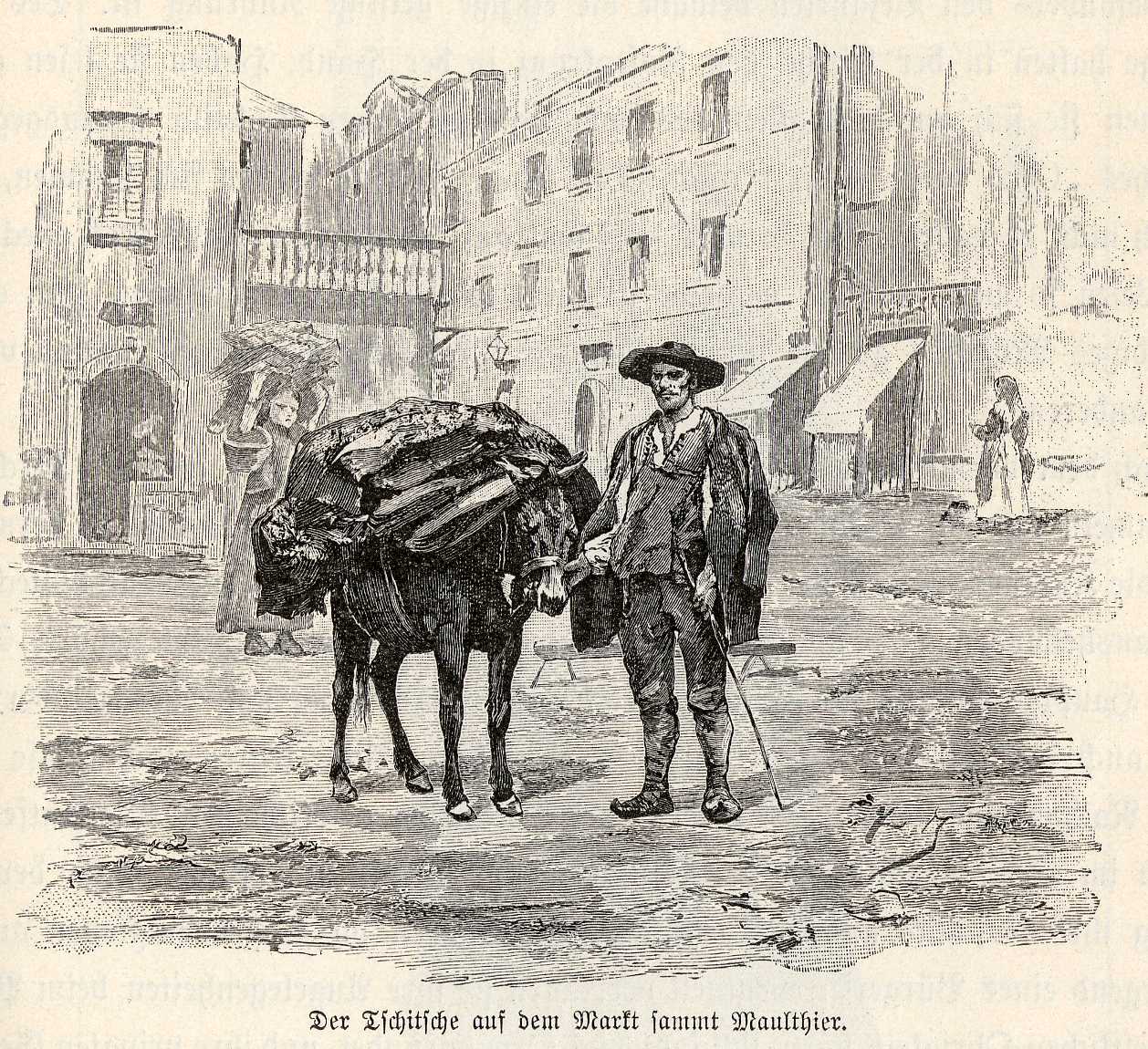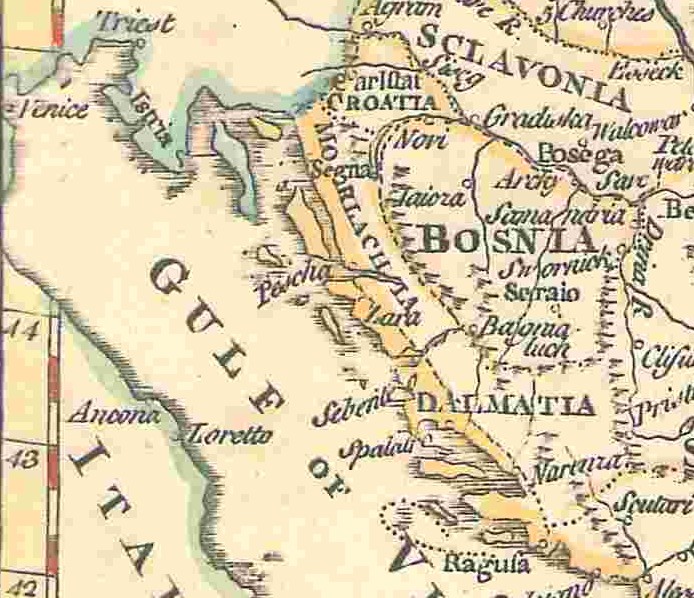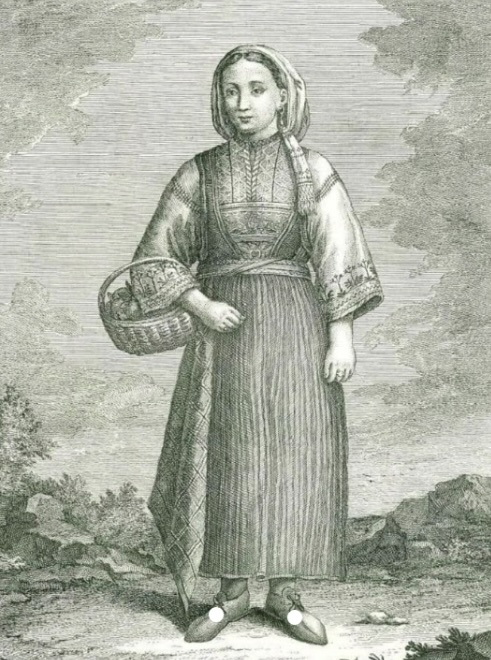|
Albanians Of Croatia
The Albanians of Croatia (; ) are people of full or partial Albanian ancestry and heritage who are an ethnic minority in Croatia. They are an autochthonous national minority recognized by the Constitution of Croatia. As such, they elect a special representative to the Croatian Parliament, shared with members of four other national minorities. The Albanian language is recognised in Croatia. In the 2011 Croatian census, there were 17,513 Albanians living in Croatia, 0.41% of total population. The largest religious groups among the Albanians were Muslims (9,594 or 54.8% of them) and Catholics (7,109 or 40.6% of them). Arbanasi subgroup, in particular are Roman Catholic of Eastern Orthodox Christians. In the 1712/14 census done in Lika and Krbava among Vlach population, and other documents, many surnames with Albanian and Arbanasi word roots were recorded, such as those with suffixes "-aj" (e.g. Bulaja, Mataija, Šolaja, Saraja, Suknajić, Rapajić), "-ez" (Kokez, Kekez, Iv ... [...More Info...] [...Related Items...] OR: [Wikipedia] [Google] [Baidu] |
Croatian Bureau Of Statistics
The Croatian Bureau of Statistics ( or DZS) is the Croatian national statistics bureau. History The bureau was formed in 1875 in Austria-Hungary as the ''Zemaljski statistički ured'' for the Kingdom of Croatia, Slavonia and Dalmatia. In 1924, the bureau was renamed to the ''Statistical Office in Zagreb'' (''Statistički ured u Zagrebu''). In 1929, after royal monarchy was proclaimed in the Kingdom of Serbs, Croats and Slovenes the bureau lost its financial and technical independence. In 1939 with the formation of the Banovina of Croatia, the office was made subject to the presidential office on the Ban's administration. In 1941 the Independent State of Croatia was formed and an ''Office of General State Statistics'' existed during this time under the control of the presidential government. In 1945 the ''Statistical Office of the People's Republic of Croatia'' was formed. In 1951 it was renamed to the ''Bureau of Statistics and Evidence'', in 1956 to the ''Bureau of Statis ... [...More Info...] [...Related Items...] OR: [Wikipedia] [Google] [Baidu] |
Croatian Parliament
The Croatian Parliament () or the Sabor is the Unicameralism, unicameral legislature of Croatia. Under the terms of the Constitution of Croatia, Croatian Constitution, the Sabor represents the nation, people and is vested with legislative power. The Sabor is composed of 151 members Elections in Croatia, elected to a four-year term on the basis of direct, universal and equal suffrage by secret ballot. Seats are allocated according to the Croatian Parliament electoral districts: 140 members of the parliament are elected in multi-seat constituency, constituencies. An additional three seats are reserved for the Croatian diaspora, diaspora and Croats of Bosnia and Herzegovina, Croats in Bosnia and Herzegovina, while national minorities have eight places reserved in parliament. The Sabor is presided over by a Speaker of the Croatian Parliament, Speaker, who is assisted by at least one deputy speaker (usually four or five deputies). The Sabor's powers are defined by the Constitution of ... [...More Info...] [...Related Items...] OR: [Wikipedia] [Google] [Baidu] |
Zagreb
Zagreb ( ) is the capital (political), capital and List of cities and towns in Croatia#List of cities and towns, largest city of Croatia. It is in the Northern Croatia, north of the country, along the Sava river, at the southern slopes of the Medvednica mountain. Zagreb stands near the international border between Croatia and Slovenia at an elevation of approximately above mean sea level, above sea level. At the 2021 census, the city itself had a population of 767,131, while the population of Zagreb metropolitan area is 1,086,528. The oldest settlement in the vicinity of the city was the Roman Andautonia, in today's Šćitarjevo. The historical record of the name "Zagreb" dates from 1134, in reference to the foundation of the settlement at Kaptol, Zagreb, Kaptol in 1094. Zagreb became a free royal city in 1242. In 1851, Janko Kamauf became Zagreb's List of mayors of Zagreb, first mayor. Zagreb has special status as a Administrative divisions of Croatia, Croatian administrative ... [...More Info...] [...Related Items...] OR: [Wikipedia] [Google] [Baidu] |
Dalmatia
Dalmatia (; ; ) is a historical region located in modern-day Croatia and Montenegro, on the eastern shore of the Adriatic Sea. Through time it formed part of several historical states, most notably the Roman Empire, the Kingdom of Croatia (925–1102), Kingdom of Croatia, the Republic of Venice, the Austrian Empire, and presently the Croatia, Republic of Croatia. Dalmatia is a narrow belt stretching from the island of Rab (island), Rab in the north to the Bay of Kotor in the south. The Dalmatian Hinterland ranges in width from fifty kilometres in the north, to just a few kilometres in the south; it is mostly covered by the rugged Dinaric Alps. List of islands of Croatia, Seventy-nine islands (and about 500 islets) run parallel to the coast, the largest (in Dalmatia) being Brač, Pag (island), Pag, and Hvar. The largest city is Split, Croatia, Split, followed by Zadar, Šibenik, and Dubrovnik. The name of the region stems from an Illyrians, Illyrian tribe called the Dalmatae, w ... [...More Info...] [...Related Items...] OR: [Wikipedia] [Google] [Baidu] |
Istria
Istria ( ; Croatian language, Croatian and Slovene language, Slovene: ; Italian language, Italian and Venetian language, Venetian: ; ; Istro-Romanian language, Istro-Romanian: ; ; ) is the largest peninsula within the Adriatic Sea. Located at the top of the Adriatic between the Gulf of Trieste and the Kvarner Gulf, the peninsula is shared by three countries: Croatia, Slovenia, and Italy,Marcel Cornis-Pope, John Neubauer''History of the literary cultures of East-Central Europe: junctures and disjunctures in the 19th And 20th Centuries'' John Benjamins Publishing Co. (2006), Alan John Day, Roger East, Richard Thomas''A political and economic dictionary of Eastern Europe'' Routledge, 1sr ed. (2002), 90% of its area being part of Croatia. Most of Croatian Istria is part of Istria County. Geography The geographical features of Istria include the Učka/Monte Maggiore mountain range, which is the highest portion of the Ćićarija/Cicceria mountain range; the rivers Dragonja/Dragogna, ... [...More Info...] [...Related Items...] OR: [Wikipedia] [Google] [Baidu] |
Zadar
Zadar ( , ), historically known as Zara (from Venetian and Italian, ; see also other names), is the oldest continuously inhabited city in Croatia. It is situated on the Adriatic Sea, at the northwestern part of Ravni Kotari region. Zadar serves as the seat of Zadar County and of the wider northern Dalmatian region. The city proper covers with a population of 75,082 , making it the second-largest city of the region of Dalmatia and the fifth-largest city in the country. Today, Zadar is a historical center of Dalmatia, Zadar County's principal political, cultural, commercial, industrial, educational, and transportation centre. Zadar is also the episcopal see of the Archdiocese of Zadar. Because of its rich heritage, Zadar is today one of the most popular Croatian tourist destinations, named "entertainment center of the Adriatic" by ''The Times'' and "Croatia's new capital of cool" by ''The Guardian''. UNESCO's World Heritage Site list included the fortified city of Zadar ... [...More Info...] [...Related Items...] OR: [Wikipedia] [Google] [Baidu] |
Vlachs In The History Of Croatia
The term ''Vlachs'' () was initially used in medieval Croatian and Venetian history for a Romance-speaking pastoralist community, called "Vlachs" and " Morlachs", inhabiting the mountains and lands of the Croatian Kingdom and the Republic of Venice ( Venetian Dalmatia) from the early 14th century. By the end of the 15th century they were highly assimilated with the Slavs and lost their language or were at least bilingual, while some communities managed to preserve and continue to speak their language (Istro-Romanians). Later in the 16th and 17th century with the Ottoman conquest and mass migrations, the term was primarily used for a socio-cultural and professional segment of the population rather than to an ethnicity, and referred to the mostly Slavic-speaking emigrants and refugees from Ottoman-held territories to the Habsburg Empire (such as Croatia) and the Republic of Venice (Dalmatia), mostly of Eastern Orthodox faith, and to a lesser degree, Catholic. With the nation-bui ... [...More Info...] [...Related Items...] OR: [Wikipedia] [Google] [Baidu] |
Vlachs Of Croatia
The term ''Vlachs'' () was initially used in medieval Croatian and Venetian history for a Romance-speaking pastoralist community, called "Vlachs" and "Morlachs", inhabiting the mountains and lands of the Croatian Kingdom and the Republic of Venice ( Venetian Dalmatia) from the early 14th century. By the end of the 15th century they were highly assimilated with the Slavs and lost their language or were at least bilingual, while some communities managed to preserve and continue to speak their language (Istro-Romanians). Later in the 16th and 17th century with the Ottoman conquest and mass migrations, the term was primarily used for a socio-cultural and professional segment of the population rather than to an ethnicity, and referred to the mostly Slavic-speaking emigrants and refugees from Ottoman-held territories to the Habsburg Empire (such as Croatia) and the Republic of Venice (Dalmatia), mostly of Eastern Orthodox faith, and to a lesser degree, Catholic. With the nation-buil ... [...More Info...] [...Related Items...] OR: [Wikipedia] [Google] [Baidu] |
Christians
A Christian () is a person who follows or adheres to Christianity, a monotheistic Abrahamic religion based on the life and teachings of Jesus Christ. Christians form the largest religious community in the world. The words '' Christ'' and ''Christian'' derive from the Koine Greek title (), a translation of the Biblical Hebrew term '' mashiach'' () (usually rendered as ''messiah'' in English). While there are diverse interpretations of Christianity which sometimes conflict, they are united in believing that Jesus has a unique significance. The term ''Christian'' used as an adjective is descriptive of anything associated with Christianity or Christian churches, or in a proverbial sense "all that is noble, and good, and Christ-like." According to a 2011 Pew Research Center survey, there were 2.3 billion Christians around the world, up from about 600 million in 1910. Today, about 37% of all Christians live in the Americas, about 26% live in Europe, 24% live in sub-Saharan Afric ... [...More Info...] [...Related Items...] OR: [Wikipedia] [Google] [Baidu] |
Eastern Orthodoxy
Eastern Orthodoxy, otherwise known as Eastern Orthodox Christianity or Byzantine Christianity, is one of the three main Branches of Christianity, branches of Chalcedonian Christianity, alongside Catholic Church, Catholicism and Protestantism. Like the Pentarchy of the first millennium, the mainstream (or "Canon law of the Eastern Orthodox Church, canonical") Eastern Orthodox Church is Organization of the Eastern Orthodox Church, organised into autocephalous churches independent from each other. In the 21st century, the Organization of the Eastern Orthodox Church#Autocephalous Eastern Orthodox churches, number of mainstream autocephalous churches is seventeen; there also exist Organization of the Eastern Orthodox Church#Unrecognised churches, autocephalous churches unrecognized by those mainstream ones. Autocephalous churches choose their own Primate (bishop), primate. Autocephalous churches can have Ecclesiastical jurisdiction, jurisdiction (authority) over other churches, som ... [...More Info...] [...Related Items...] OR: [Wikipedia] [Google] [Baidu] |
Catholic Church
The Catholic Church (), also known as the Roman Catholic Church, is the List of Christian denominations by number of members, largest Christian church, with 1.27 to 1.41 billion baptized Catholics Catholic Church by country, worldwide as of 2025. It is among the world's oldest and largest international institutions and has played a prominent role in the history and development of Western civilization.Gerald O'Collins, O'Collins, p. v (preface). The church consists of 24 Catholic particular churches and liturgical rites#Churches, ''sui iuris'' (autonomous) churches, including the Latin Church and 23 Eastern Catholic Churches, which comprise almost 3,500 dioceses and Eparchy, eparchies List of Catholic dioceses (structured view), around the world, each overseen by one or more Bishops in the Catholic Church, bishops. The pope, who is the bishop of Rome, is the Papal supremacy, chief pastor of the church. The core beliefs of Catholicism are found in the Nicene Creed. The ... [...More Info...] [...Related Items...] OR: [Wikipedia] [Google] [Baidu] |
Arbanasi People
Arbanasi ( Arbanasi: ) is an ethnic community in and around the city of Zadar in the northern Dalmatia region of Croatia, who are of Albanian ethnic origin. They are traditional speakers of the Arbanasi dialect of Gheg Albanian. Their name is an obsolete way to say ''Albanians'' in Croatian and is the toponymy of the first Arbanasi settlement in the region, which today is a suburb of Zadar. In Albanian literature, they are known as "Albanians of Zadar" (). Distribution Today, the community is spread across Croatia. Their original settlements were Arbanasi of Zadar and some villages around Zadar, namely Zemunik, Gračac, Dračevac, Crno, Ploča, etc. The former village derived its name from its founders, the Albanians. The Arbanasi are known to have settled the area during two different periods of migration; the first in 1655 and the second in 1726–33. History 18th century migration and resettlement ''Arbanasi'' () is the old ethnonym that the South Slavs used to deno ... [...More Info...] [...Related Items...] OR: [Wikipedia] [Google] [Baidu] |







